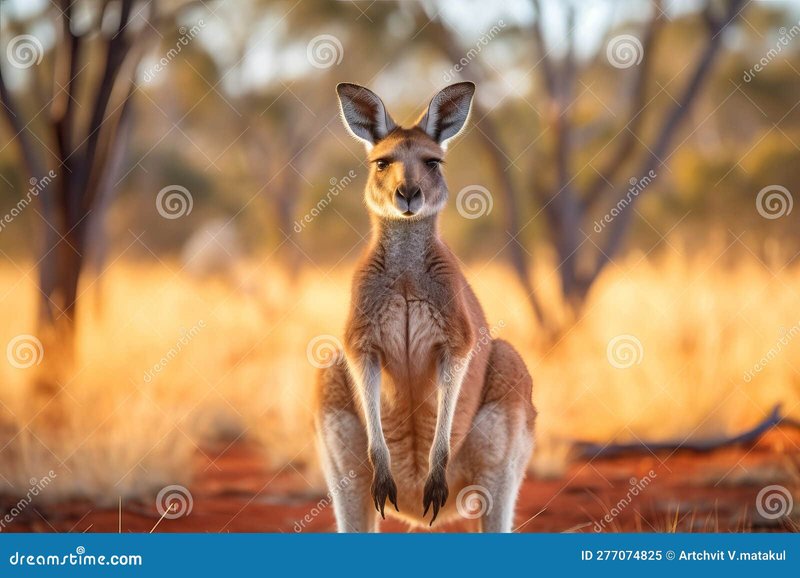
Encountering wildlife can be magical, but it can also be a bit intimidating. Red kangaroos are the largest marsupials and can grow to be quite large, with males standing over 6 feet tall! If you’re not sure how to react in such a situation, fear not—I’ve got your back. In this guide, we’ll explore various scenarios, safe actions to take, and some fascinating facts about these unique animals.
Understanding Red Kangaroos
Red kangaroos are iconic symbols of Australia. Picture them hopping elegantly across the plains or lounging under the shade of a tree. But these aren’t just cute critters; they play a significant role in their ecosystem. They mainly graze on grasses and are well-adapted to living in arid environments.
You might be wondering why they’re called “red.” While males often showcase a reddish-brown color, females are typically a more grayish hue. The differences can help you identify their gender from a distance. Plus, their long strong legs and powerful tails are specially designed for hopping great distances—up to 30 feet in a single bound! It’s nature’s way of equipping them for survival.
Stay Calm and Assess the Situation
If you find yourself face-to-face with a red kangaroo, the first thing to do is stay calm. This isn’t the time to panic. Much like meeting a dog on the street, your reaction can affect how the kangaroo responds. They can sense your emotions. If you’re anxious, they might feel threatened.
Now, take a moment to assess the scenario. Is the kangaroo alone, or are there others around? Are they feeding, or did you accidentally surprise them? These observations can help you gauge whether they’re likely to act defensively. Honestly, if they’re peacefully munching on grass, you probably won’t need to worry too much.
Back Away Slowly
Once you’ve assessed the situation and are feeling calm, it’s time to back away slowly. Rapid movements might trigger a flight or fight response, so think of this like doing the moonwalk—smooth and steady! Make eye contact occasionally but don’t lock eyes for too long; it can be perceived as a challenge.
As you step back, keep your voice low and soothing. Something like “Hey there, buddy” might help lighten the mood! Continue to move in a backward motion until you feel you’re at a safe distance. This generally means about 50 feet away, depending on the kangaroo’s behavior. The further you are, the better for both you and the kangaroo.
Know When to Leave the Area
In some cases, it might be best to leave the area entirely. If the kangaroo appears agitated or starts to approach you, it’s a clear indication to go. Remember, while they might look adorable, they can kick with immense power if they feel threatened.
Here’s a little insight: red kangaroos have a social hierarchy, and an approaching kangaroo might be asserting its dominance. If you’re being followed or approached, it’s definitely time to skedaddle! Use your good judgment—if something feels off, trust your instincts and prioritize your safety.
Understanding Their Behavior
Kangaroo behavior can be complex and fascinating. They are usually more active during the early morning or late afternoon, which means those times are prime for spotting them. If you encounter a kangaroo during these hours, they might be more alert and cautious.
Interestingly, red kangaroos have a unique way of communicating. You may hear them thumping on the ground with their feet as a warning to others nearby. This is their version of a “code red” alert! If you hear this, it’s a sign to take a step back.
Also, keep in mind that during mating season, males can be a bit more aggressive. It’s their nature! If you happen upon a lone male guarding a territory, tread carefully.
Respect Their Space and Habitat
Kangaroos thrive in their natural environment, and it’s crucial to respect that. When observing them, be mindful not to encroach on their space. Keeping a respectful distance not only protects you but also the kangaroo.
Consider this: when you’re at a gathering, and someone gets too close for comfort, you might feel uneasy. Kangaroos feel the same way! If you love wildlife watching, invest in binoculars to observe them without disturbing their natural behaviors. It’s like getting front-row seats to a nature show without all the awkwardness.
What to Do After the Encounter
Once you’ve safely distanced yourself, take a moment to appreciate the experience. These encounters can be rare and beautiful. Grab your phone and snap a picture (from a safe distance, of course)! Documenting the moment could also help raise awareness about kangaroo conservation.
Additionally, if you’re in a more populated area, report your encounter to local wildlife authorities. This can help them keep track of kangaroo populations and ensure they’re safe and healthy in their natural habitat. By sharing your experience, you contribute to the protection of these amazing creatures.
Final Thoughts on Encountering Red Kangaroos
Encountering a red kangaroo in the wild can be exhilarating yet intimidating. It’s essential to maintain a calm demeanor, back away slowly, and respect their space. Remember, they are a vital part of Australia’s wildlife, and witnessing their beauty is a privilege.
So the next time you roam the Australian outback and spot that tall, bouncing figure, you’ll know exactly what to do. Enjoy the moment, snap a pic, and embrace the magic of nature. Always remember to prioritize safety—for both you and the kangaroo! Happy exploring!

